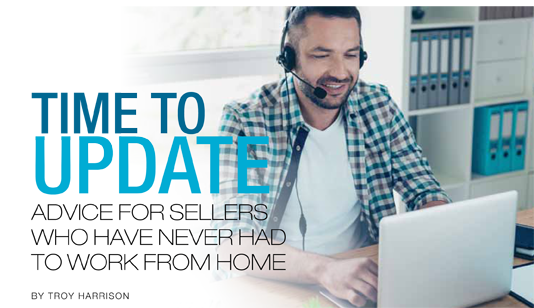Time to update

By Troy Harrison
Boy, has our world changed. Thirty days ago, we were rocking and rolling along with not a care in the world. Now, unless you live in a select few states, you’re basically on lockdown. Even salespeople in “essential” businesses are reporting that their customers either don’t want to, or can’t, see them face to face. This has huge implications for many salespeople who have, throughout their careers, relied solely on face-to-face sales calls to make their impact, show their value, and hit their quota.
A couple of months ago, I was doing a training program where we discussed LinkedIn as a small part of the program. Half of the salespeople in the room basically said the same thing: “I just show up on the job site and do my selling there – I don’t need or want to know how to use that stuff.” Those salespeople are struggling now. If your entire sales approach is dependent upon in-person interaction, you’re dead in the water. What’s more, sales itself will change because of what we’re going through with the pandemic, so it’s time to adapt and update. Let’s talk about how.
Make no mistake, selling is still happening, and people are buying things (and not just N95 masks). They are just doing it through different venues: Over the phone, by web conference and, yes, on social media. We’ll leave social media for another day, but let’s talk today about how to maximize your selling through phone and web conferencing.
“But, Troy, I know how to sell over the phone!” Do you? Maybe you do, and maybe you don’t. In any case, here are a few things you might want to understand:
1. Get a good phone. I know, that sounds elementary, but all phones are not made the same. Some smartphones are far more “smart” than “phone,” and leave you sounding like you are calling from the bottom of a barrel. When I go phone shopping, I take my wife with me, pick out a few possibilities, and then have her go outside. I call her from the demo phones so I can check the quality of incoming and outgoing sound. That plays a big role in my choice.
2. Also, get a headset. You should also have a quality headset. Mine is a BlueParrott B250-XT. For the best call quality, I prefer one that actually covers at least one ear and has a microphone that goes in front of my mouth. Sure, there are smaller units, and ones that don’t make you look like you’re an unpaid extra on the old Battlestar Galactica TV show – but mine has great sound quality, and that’s why I like it. Full disclosure; I resisted a Bluetooth headset until two years ago when I was called upon to do a three-hour webinar. Now I seldom make any phone call longer than five minutes without using it. Why a headset if you have a good phone, as in above? The phone quality is for short calls and when someone calls you – this one is for longer calls when you are calling.
3. Don’t use speakerphone. Please. For all that is good and holy in selling, do not use speakerphone – your customers will spend a lot of time saying, “Can you repeat that?” If you can’t be heard, you can’t sell.
4. Remember that the phone compresses conversation. A sales call that would normally occupy an hour will now take 30 minutes. This is because a lot of the “small talk” that fills time tends to get tossed over the side in a phone call. Your ability to get to the point will be critical, as will your ability to have a quality game plan for the call.
The phone is great, of course, but many customers will still want to see your face – and you theirs. If you aren’t already proficient, or at least competent, at video conferencing, it’s time to get proficient. I’m not going to discuss particular platforms here, for two reasons. First, that’s not my expertise, and second, many of your customers will have their own preferred platform. These are general tips that will help with most platforms.
1. Consider the background. The camera on your laptop (or phone or tablet) can see a lot more than just you. Think about what’s behind you, beside you, and in the view of the camera, and how that might distract from your image. I did a web conference a year ago with a guy who was doing the conference from his dining room. No judgment there – I do the same thing – but behind him, I could see a sink full of dirty dishes! That’s not a great image. Think about what’s in view; the background doesn’t have to be blank – in fact some objects can be interesting – but what’s behind you shouldn’t distract from the call.
2. Consider the view. Now I’m talking about the view of you. You don’t have to be in full dress clothes, but you should be in a nice shirt. The camera lens on whatever device you are using should be at eye level. If you have a laptop on your desk, to get the lens aimed at you, the camera will be angled up. Nobody looks good like that. Trust me on this. If I’m doing a webinar on my laptop, I will boost the laptop with coffee table books (this is a highly technical process, folks) so that the camera is level with my eyes. The camera also shouldn’t be angled down at you – so get rid of those habits you’ve developed for great selfies. You should appear level and eye to eye with your customer.
3. Look at the camera, not the screen. This is something I still struggle with. It’s only natural to look at the image on your screen, but if you do that, you will never be making eye contact with your customer; you’ll be looking down as if you’re reading from notes. This is a bad look. When you’re speaking, look at the camera, and when your customer is speaking, look at their image on the screen.
4. Remember the sound. I would advise not trusting the built-in microphone on your device if at all possible. Many times, on webinars, I’ll use the separate call-in number with my headset (hence the Battlestar Galactica reference earlier). I also have a USB microphone that plugs into my laptop in case I need to use the webinar’s sound system; again, the sound quality is much better this way.
5. Test. Have you recorded a video on your device yet? You should. Set it up exactly like you will in the web conference, record a video of yourself speaking, and then play it back. If you don’t like what you see, make changes until you do – whatever you see is what your customers will see.
6. Show up early. We all know about showing up to a face-to-face sales call 10 minutes early, but webconferences induce the bad habit of showing up at the appointed time. Don’t do it. Instead, log on 10 minutes early and test your tech. Some apps will require you to download an app before you start, and if you show up at 9:59 for a 10:00 a.m. call, you’ll be late. If you show up early, you can test the video and the sound and make sure all the tech is working. Always test the tech.
That should get you started, if you haven’t already started, on becoming more effective at selling on the phone and on the web. Make no mistake – selling will not go 100 percent back to where it was. These things never do. Some of your customers will decide that they prefer phone or web contact, as an example, and those salespeople who get good at those technologies now will be far ahead.
It’s time to update and stay relevant.
 Troy Harrison is the author of “Sell Like You Mean It!”, “The Pocket Sales Manager,” and a speaker, consultant and sales navigator. He helps companies build more profitable and productive sales forces. To schedule a free 45-minute sales strategy review, call (913) 645-3603, email Troy@TroyHarrison.com or visit www.TroyHarrison.com.
Troy Harrison is the author of “Sell Like You Mean It!”, “The Pocket Sales Manager,” and a speaker, consultant and sales navigator. He helps companies build more profitable and productive sales forces. To schedule a free 45-minute sales strategy review, call (913) 645-3603, email Troy@TroyHarrison.com or visit www.TroyHarrison.com.
This article originally appeared in the May/June 2020 issue of Industrial Supply magazine. Copyright 2020, Direct Business Media.











